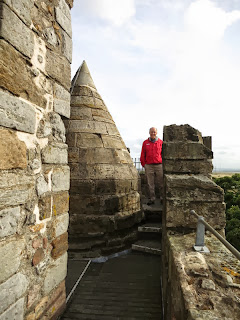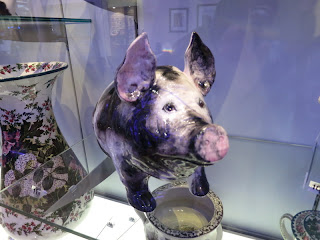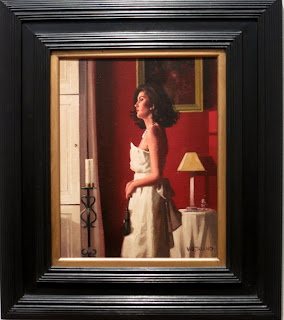The morning began with our exploration of the village of Biggar. We had seen the sign for a Puppet Theater near our B&B, and we made that first on our list. Sure enough, we found a beautiful old mansion which housed a Puppet Theater.
Marty was kind enough to stand outside the wall that featured the Sign for Purves.
Marty was kind enough to stand outside the wall that featured the Sign for Purves.
We checked the performance schedule, but when we saw that the only showing today was for "Pippa and Panda Meet the Tooth Fairly", we both decided that our time would be better spent on other things.
So, we walked around the town and found some real surprises.
Here you can see the oldest house in the village of Biggar.
It was once an inn and it housed retreating Jacobite rebels from the army in 1746.
Marty was happy to demonstrate just how low the doorway was.
We stumbled upon a Gas Works museum just a block away from High Street.
We were surprised to read that Coal had been used as a fuel to make gas which was then pumped to the houses in Biggar for heating.
Marty was impressed with the wheels at the tops of the tank that allowed it to "float".
Outside the community center there is a statue of a snow shovel:
It was invented by an engineer named Cutherbertson who came from Biggar. If you look closely, you can just catch Marty admiring it.
Finally, we passed by the Moat Park Heritage Center, but it was too early to actually go through it.
Actually, all of the sites in Biggar had late openings, so we decided to jump in the car and head to New Lanark.
This place was fascinating. It is now a preserved Unesco World Heritage site and it is set up so that as you descend the steps from the car park, you actually feel like you are being transported back in time to the early 1800's.
At that time, there was a working cotton mill and housing tenements on this location. Hydraulic power was used to run the mill and it actually continues to work as such, but with wool rather than cotton.
In fact, Britain led the world in developing steam power in the 18th and 19th century.
In the early 1800's a man by the name of Robert Owen purchased the mill. He was responsible for setting up this community where people had decent housing, free medical care, and were encouraged to maintain cleanliness by sending health visitors known as "Bug Hunters"to every family residence.
He began the first nursery school and set up education on site for the community.
Here Marty poses next to a globe that is a replica of the original from 1828 which was 19 ft in circumference.
Some other interesting facts about Owen were that he did not believe in punishment, but rather, depended upon the Book of Character to keep people honest and hard working.
Owen firmly believed that well educated people were the best workers and that there would not be any tendency to stray towards crime.
Owen was responsible for one of the first cooperatives, purchasing high quality foods in bulk, then selling them in the New Lanark store at a much lower cost than what could be purchased elsewhere. People ate better because they could afford it. You have to admit, this was really radical thinking on the part of the business owner in the early 1800's.
Unfortunately, Owen succumbed to the pressure from other businessmen who did not understand his compassion for the working class. He ended up selling the mill and moving to Harmony, Indiana, where he attempted to build a similar community.
There were several building which we could tour that took us back in time to understand the living conditions of these mill workers. And, we were even able to watch wool being spun onto skeins in large quantities. It was fascinating to see the machinery at work.
On the top of Mill #3, there is a lovely rooftop garden.
Marty wanted his photo taken with these bunnies.
As I mentioned, hydropower is used to operate the machinery, and we had the opportunity to seek out the source.
We need only follow the badger to the Falls of Clyde.
And here they are:
But they weren't the real source of the hydropower. Hiking up a pretty steep hill offered us the view of the Corra Linn Falls.
Now, those were spectacular
The loud rush of the water filled the air.
There was another set of falls yet further up the mountain, but we decided that we'd had enough climbing for the day, so we headed back down to the village see just what we might have missed.
I'd have passed on this room but Marty seemed pretty fascinated playing with this bat.
Don't bother asking me what this exhibition encompassed because I high tailed it out of there as soon as I took the photo. Too creepy for me!
My favorite part of the day involved a conversation with a woman named Leslie who stamped our tickets in Mill #1. She recognized our accents as being "foreign" and she asked us where we came from. We told her that we were from Pennsylvania in the United States, and she eagerly asked us if she could have our opinion on something.
We agreed, and she pulled out a book on Traveling Route 66. It has apparently been this woman's dream to come to the United States and travel Route 66 from Chicago to California. Her original thought had been to take a bus tour.
Well, during the conversation, we found out that Leslie has a friend named Louise. Louise also was rather interested in making this tour with Leslie.
By the time that we were finished with our conversation, Marty nearly persuaded Leslie to forget about the bus tour, fly into Chicago, rent a Mustang Convertible, take along Louise, and drive it herself.
I'm just hoping that if Leslie does follow Marty's advice, and brings Louise along, that she has better luck than Thelma!






































+by+John+McGhie.JPG)




















